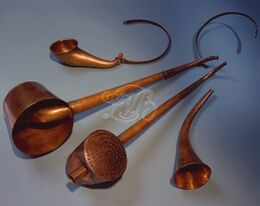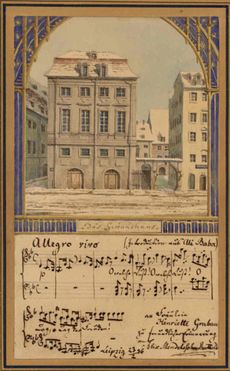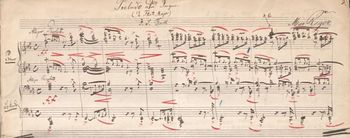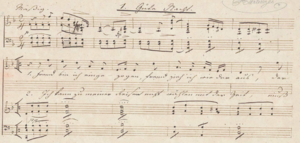Template:DRM manuscripts by composer
Contents
- 1 By Composer
- 1.1 Ludwig van Beethoven: Beethoven-Haus, Bonn
- 1.2 Ludwig van Beethoven: Beethoven Autographs Online
- 1.3 Beethovens Werkstatt (Beethoven's Workshop)
- 1.4 Johannes Brahms (Institute)
- 1.5 Anton Bruckner
- 1.6 John Cage Living Archive
- 1.7 The Aaron Copland Collection (Library of Congress)
- 1.8 Edvard Grieg
- 1.9 Handel's Messiah and other virtual "page-turners" from the British Library
- 1.10 Handel autographs and other music manuscripts
- 1.11 Michael Haydn Manuscripts
- 1.12 Gustav Mahler Autograph Manuscripts
- 1.13 Felix Mendelssohn Materials (Library of Congress)
- 1.14 Carl Orff Autograph Manuscripts
- 1.15 Max Reger Autograph Manuscripts
- 1.16 Cipriano de Rore: Illuminated Choirbook from the Court of Albrecht V
- 1.17 The Arnold Schönberg Center
- 1.18 Schubert Online
- 1.19 Strauss Online
- 1.20 Richard Strauss
- 1.21 Verdi Online
- 1.22 Georg Josef Vogler Music Manuscripts
- 1.23 Richard Wagner: Notebooks, music manuscripts, and correspondence
- 1.24 Robert Ward Papers
- 1.25 Manuscripts of Ermanno Wolf-Ferrari
By Composer
Ludwig van Beethoven: Beethoven-Haus, Bonn
Website: Beethoven Haus, Bonn
The digital archive at the Beethoven-Haus, Bonn, contains manuscripts, sketches, letters, pictures, sample sound recordings, and much else. Beethoven lived here, and the physical museum also houses his instrument collection. A recently funded project involving the Beethoven-Haus and the Musikhochschule in Detmold will develop an ambitious "Beethoven Werkstaat" project taking viewers through the development of individual works by way of sketches and editions.
Ludwig van Beethoven: Beethoven Autographs Online
Website: Beethoven Autographs Online
Boston University's Beethoven Center offers several tools for Beethoven scholars and performers. Among them Beethoven Autographs Online is a one-stop shop for rare materials ranging from fragments, sketches, and cadenzas to complete manuscripts of full scores from libraries and private collections across Europe and North America. Its reference system conflates diverse work-numbering schemes into one easily searchable whole.
Beethovens Werkstatt (Beethoven's Workshop)
Website: Beethovens Werkstatt
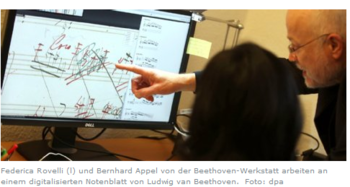
The ambitious Beethovens Werkstatt project, officially launched in 2014, will between now and 2030 reconstruct (with images and critical notes) the path of development of Beethoven's works from inception to completion. This project is based on the composer's sketch books, which in the digital version are to be carefully annotated with the help of the Music Encoding Initiative [MEI], a markup language for the encoding of musical sources facilitating their citation in critical editions. Bernhard Apel (Beethoven-Haus, Bonn) and Joachim Veit (Musikwissenschaftliches Institut, Detmold/Padlerborn) are the project directors. Johannes Kepper (Edirom project) is centrally involved in the technical development of both Werkstatt and MEI. The link above shows a prototype browser for viewing both manuscript iterations and modern notation for variants in the first movement of Beethoven's C-Minor Piano Sonata Op. 111 in Variants 14–17 (Beethoven-Haus BH 71).
Johannes Brahms (Institute)
Website: Johannes Brahms (Institute)
The Brahms Institute in Lübeck hosts a composite site for autographs, early editions, letters, and other kinds of documentation associated with Brahms. In this last category are such things as concert programs and fragments of music, drawings, and photographs of and by his associates.
See also the Johannes Brahms organization site.
Anton Bruckner
Website: Web Archive Anton Bruckner
The multi-faceted Anton Brucker web archive at the Austrian Academy of Sciences contains 26,000 images of the composer's autographs and early copies plus 6000 images of early prints. An associated database cites c. 10,000 works and related literature. The project is managed by Robert Klugseder. Online editions prepared with Edirom are in preparation.
John Cage Living Archive
Website: John Cage Living Archive
The New York Public Library for the Performing Arts, in collaboration with the John Cage Trust and the publisher C. F. Peters, hosts this sampler of Cage's physically diverse manuscripts. At a glance the reader can see the broad diversity of Cage's approaches--arithmetical, schematic, electronic, and aleatoric. A search engine has filters for video, manuscript, and ephemeral material. Video contributions of performances of Cage's music are actively sought via this form.
The Aaron Copland Collection (Library of Congress)
Website: The Aaron Copland Collection
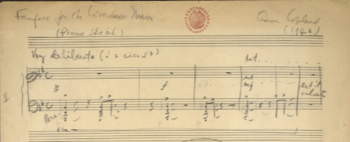
The Aaron Copland Collection, available at the Library of Congress, is an exceedingly rich one that contains every imaginable kind of evidence of the composer's long life (1900–1990)—manuscripts, sketches, typescripts for talks, personal photographs (roughly 5,000 of them), childhood mementos, and letters. Apart from photos, 981 other items can be found here.
Edvard Grieg
Website: Material regarding Edvard Grieg
Shortly before his death Edvard Grieg (1843-1907) arranged for the donation of all his music, letters, and related materials to the Bergen Public Library. The origins of the digitization project date back to 1993, the 150th anniversary of Grieg's birth. Grieg had a deep interest in recording technologies of his time. Starting in 1903 he made nine recordings of his music (on 78s), player-piano rolls from live-performance (Ludwig Hupfeld's Phonola and Welte-Mignon), and the Aeolian Company. For the last he suggested tempo mappings.
Handel's Messiah and other virtual "page-turners" from the British Library
Websites: See below.
The British Library's Virtual Books website contains a number of important manuscripts, the folios of which can be "turned" by the user. In addition to the autograph score of Handel's Messiah, "Sumer is icumen in", the Old Hall manuscript, the manuscript for Book II of J. S. Bach's Well Tempered Clavier, a Purcell anthem for the coronation (1685) of James II, sketches for Beethoven's Sixth ("Pastoral") Symphony, Elgar's "Enigma" Variations, and Mozart's musical diary (Zweig MS 63) are set up in similar fashion. A listing of other viewable musical works can be found here.
Handel autographs and other music manuscripts
Website: Handel autographs
The British Library completed the digitization of 38 Handel autograph manuscripts in 2016. They are accessed through the Library's "catalogs, archives, and manuscripts" website, where the user may limit the date range (slider at the bottom of the form). An author search for "Handel autographs" (currently yielding 168 hits) picks up unrelated miscellany, while a search for Handel alone produces a list of 103 titles. Items listed range from definitive scores of myriad operas, oratorios, cantatas, and other vocal and choral works to miscellaneous pieces (especially arias) collected by John Christopher Smith, Handel's copyist.
Among other composers represented, we find 311 manuscripts associated with the Bach family (52). Searches for other composers yield these figures: Thomas Arne (57), Giovanni Bononcini (58), William Boyce (115), William Byrd (141), Joseph Haydn (239), Orlando de Lassus (48), Benedetto Marcello (52), Wolfgang Amadeus Mozart (297), Pierluigi Palestrina (99), Giovanni Paisiello (84), Henry Purcell (233), and Alessandro Scarlatti (84), Franz Schubert (95), and William Walton (374).
The Handel autographs all have live links (2016), while many other listings currently contain catalog information. Holdings responding to composer searches may also yield correspondence, deeds, and other personal papers.
Michael Haydn Manuscripts
Website: Michael Haydn Manuscripts
181 comprehensive titles from the Bavarian State Library. The heavy emphasis on liturgical music reflects Haydn's lifetime involvement in church music, mainly in Salzburg and Vienna.
Gustav Mahler Autograph Manuscripts
Website: Mahler Autograph Manuscripts
30 volumes of autograph manuscripts by Gustav Mahler are housed in the Bavarian State Library (Munich). Offerings include Das Knaben Wunderhorn, sketches for three symphonies, and Mahler's correspondence with Emil Hertzka.
Felix Mendelssohn Materials (Library of Congress)
Website: Felix Mendelssohn Materials
The Library of Congress holds a collection of miscellaneous Mendelssohn memorabilia that includes letters, lithographs, printed, and manuscript music. The illustration here shows a watercolor of the Gewandhaus, Leipzig, by Mendelssohn from the scrapbook of Henriette Grabau, a singer who appeared there when Mendelssohn conducted in 1836. The musical except beneath it comes from the Cherubini's opera Ali Baba. Manuscripts of the Lieder ohne Wörte and the Octet, as well as drawings from his travels in Italy, are among the holdings.
Carl Orff Autograph Manuscripts
Website: Orff Autograph Manuscripts
This collection of manuscript materials (91 titles) documents the musical career of Carl Orff (1895–1982). It includes, Lieder, stage works, modern arrangements of Monteverdi operas, and other materials. Because of continuing copyright restrictions, many items can be consulted only on site in the Bavarian State Library. Nonetheless the detailed listing is valuable in documenting the range of Orff's interests and activities.
Max Reger Autograph Manuscripts
Website: Reger Autograph Manuscripts
The music of Max Reger (1873–1916) occupies a unique place in the keyboard repertory of its time. His organ works are better known than his other music—concertos, Lieder, choral works, and a clarinet quintet. Forty titles are viewable here.
Cipriano de Rore: Illuminated Choirbook from the Court of Albrecht V
Website: Cipriano de Rore: Illuminated Choirbook from the Court of Duke Albrecht V
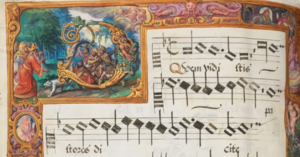
The brilliant colors and generous proportions of this choirbook, illuminated by Hans Mielich (1516-1573) for the Court of Albrecht V of Bavaria are stunning to behold. It is dated 1559. The books includes portraits of the duke, Duchess Anna, and of the composer. Rore (c. 1515-1565) was mainly active in Italy. He moved to Munich from Ferrara in the summer of 1559, which suggests that the bulk of the motets found here were composed prior to his arrival. Two volumes of his motets had been published in Venice in the 1540s. A further one followed in 1563.
The Arnold Schönberg Center
Website: The Arnold Schönberg Center
The Arnold Schönberg Center in Vienna holds a cornucopia of Schönberg memorabilia that extends to film footage of the composer's real-world experiences such as being briefly employed as an auto salesman, his "contacts" list, and personal photographs, provides an online list of works, biographical sources, and information on performing rites. Autograph fair copies, sketches and drafts of Schönberg's compositions; autograph manuscripts and other primary sources for Schönberg’s theoretical writings and literary works; writings on musical pedagogy, as well as lectures and teaching materials; early printed copies of Schönberg’s works, including autograph annotations, performance instructions, and revisions; personal documents; Schönberg’s complete library; programs, reviews, posters; photographs and audiovisual documents all form part of the collection.
Schubert Online
Website: Schubert Online
Schubert Online offers combined access to a total of 636 autograph scores, letters, and other documentation on Schubert. Much of the work was facilitated by the Vienna Science and Technology Fund [WWTF or Wiener Wissenschafts-, Forschungs- und Technologiefonds]. Digitized holdings come from Vienna's City Hall [Rathaus], the Austrian National Library, the State Library of Berlin, and the National Library of Norway, with intellectual contributions from the Music and Psychology program in Cologne and the Musicology Institute at the University of Vienna. Full-text search is supported for the letters. Deutsch Numbers are used to identify the manuscripts.
Strauss Online
Website: Strauss Online
The music of three Johanns (father, son, uncle), one Josef, and one Eduard is represented at this website based at the city library of Vienna. More than 300 works are available here. Almost 200 of them are by Johann Strauss the younger, the waltz king. A few sketches, operettas, marches et al. are included. The minor Strausses composed polkas as well as other short instrumental pieces. Eduard's Theorie der Musik from c. 1845-50 can be downloaded here. An online catalogue of the library's printed works is available here.
Richard Strauss
Website: Richard Strauss: Musical Autographs
Among these 84 titles are numerous sketches, fragmentary compositions, and Lieder. The originals are held in the Bavarian State Library.
Verdi Online
Website: Verdi Online
The Verdi Online collaboration hosts diverse materials--libretti, letters, portraits and figurines, bibliography, discography, and large quantites of background information about places and people associated with Giuseppe Verdi.
Georg Josef Vogler Music Manuscripts
Website: Vogler Music Manuscripts
Abbe Vogler (1749–1814) left a substantial collection of manuscripts (75 titles) that includes chamber and sacred music, concertos and symphonies, plus several items that relate to his opera Castor et Pollux.
Richard Wagner: Notebooks, music manuscripts, and correspondence
Website: Richard Wagner: Notebooks, music manuscripts, and correspondence
This collection of unpublished materials from the archive of the Bavarian State Opera brings Wagner's goals and working habits into our midst. Under 170 rubrics it documents the composer's movements, collaborators, and evolving ideas about music and role of music in society. They also give a more rounded view of his range of interests than many published accounts.
Robert Ward Papers
Website: Ward Papers
Robert Ward was an American composer primarily of operas, instrumental works, and symphonic choral works. He won the 1962 Pulitzer Prize in Music for his opera, The Crucible, which remains his best-known work. His exceptionally long life (1910-2012) enabled him to compose for 95 years! Ward studied at the Eastman School of Music in the 1930s and subsequently taught at Columbia University, North arolina School of the Arts, and Duke University.
Manuscripts of Ermanno Wolf-Ferrari
Website: Manuscripts of Ermanno Wolf-Ferrari
Ermanno Wolf-Ferrari (1876–1948) followed the path of aspiring students of his time in examining the details of earlier composers' practices. This collection of his manuscripts (175 titles) includes transcriptions of keyboard works by J. S. Bach, sketches of operas, concertos, symphonies, comic operas, a passion, sonatas, string quartets, and other chamber music.
